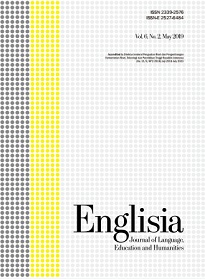Indonesian L2 learners’ listening anxiety and socio-affective listening strategy: A survey study
DOI:
https://doi.org/10.22373/ej.v9i2.10708Keywords:
Second language (L2), Listening anxiety, Socio-affective listening strategy (SALS), SurveyAbstract
The present study was conducted to investigate the possible interaction between the second language (L2) learners' listening anxiety and their use of socio-affective listening strategies (SALS). The participants of this study were 74 university learners from non-English departments at a university in Java, Indonesia. The study used the survey method of distributing Google Form questionnaires. Through descriptive statistics, the study found that generally, learner participants had a medium level of listening anxiety. The participants also reported a high level of SALS. Through correlation formula, the study further found that learners’ use of SALS correlated negatively with their listening anxiety. It indicated that the more they used SALS, the lower their listening anxiety tended to be. The correlation was not significant. Based on the findings of the study, several pedagogical implications were suggested. This included promoting more learner-centred activities where learners could develop their socio-affective strategies and giving emphasis on overall comprehension rather than specific grammatical aspects in L2 listening activities. Possible directions for future studies were also suggested concerning the study's findings and possible limitations.
Downloads
References
Allah, T. A. (2016). Social-affective strategy instruction in EFL materials: The case of English textbooks and official programs in Tunisia. International Journal of Humanities and Cultural Studies (IJHCS) ISSN 2356-5926, 2(4), 169–195.
Bao, D., & Guan, C. (2019). Listening strategies. The TESOL Encyclopedia of English Language Teaching, January 2019, 1–6. https://doi.org/10.1002/9781118784235.eelt0588
Bao, X. (2017). A study on listening strategies instructed by teachers and strategies used by students. International Journal of English Linguistics, 7(2), 186–195. https://doi.org/10.5539/ijel.v7n2p186
Dalman, M. R. (2016). The relationship between listening anxiety, listening comprehension strategies, and listening performance among Iranian EFL university students. International Journal of Modern Language Teaching and Learning, 1(6), 241–252.
Firdaus, M. I. (2019). Listening comprehension strategies used by EFL students in State University of Surabaya. RETAIN, 7(3), 48–56.
Gilanlioglu, I., & Kalajahi, S. A. . (2010). The use of language learning strategies: Turkish vs Iranian EFL learners. ILI- Language Teaching Journal, 6(1–2), 108–134.
Golchi, M. M. (2012). Listening anxiety and its relationship with listening strategy use and listening comprehension among Iranian IELTS learners. International Journal of English Linguistics, 2(4), 115–128. https://doi.org/10.5539/ijel.v2n4p115
Gray, D. E. (2014). Doing research in the real world (3rd ed.). London: Sage Publications, Ltd.
Hidayati, A. N., Dewi, N. S. N., Nurhaedin, E., & Rosmala, D. (2020). Foreign language listening anxiety in an academic listening class. J-SHMIC: Journal of English for Academic, 7(2), 1–9.
Horwitz, E. K. (2001). Language anxiety and achievement. Annual Review of Applied Linguistics, 21, 112–126.
Israel, M., & Hay, I. (2006). Research ethics for social scientists. London: Sage Publications.
Liu, M., & Thondhlana, J. (2015). A study of Chinese University EFL learners’ foreign language listening anxiety, listening strategy use and academic listening performance. Indonesian Journal of English Language Teaching, 10(1), 30–47.
Loren, F. T. A., Andayani, A., & Setiawan, B. (2017). The use of learning media on listening skill in teaching Indonesian to speakers of other language (TISOL). Lingua Didaktika: Jurnal Bahasa Dan Pembelajaran Bahasa, 11(1), 1–12. https://doi.org/10.24036/ld.v11i1.7625
Nowrouzi, S., Sim, T. S., Zareian, G., & Nimehchisalem, V. (2014). Self-perceived listening comprehension strategies used by Iranian EFL students. International Journal of Applied Linguistics and English Literature, 3(6), 35–41. https://doi.org/10.7575/aiac.ijalel.v.3n.6p.35
Prastiyowati, S. (2019). Anxiety on students’ listening comprehension in university students in Malang. A Journal of Culture English Language Teaching Literature & Linguistics, 6(1), 65. https://doi.org/10.22219/celticumm.vol6.no1.65-77
Ramrathan, L., Grange, L., & Shawa, L. B. (2016). Ethics in educational research. In Education studies for initial teacher development (pp. 432–443).
Rouhi, A., Nabavi, S. M., & Mohebbi, H. (2014). The effects of previewing questions, repetition of input, and topic preparation on listening comprehension of Iranian EFL learners. Iranian Journal of Language Teaching Research, 2(2), 73–85.
Saeidi, M., & Khaliliaqdam, S. (2013). The effect of socio-affective strategies on students’ test anxiety across different genders. Theory and Practice in Language Studies, 3(2), 269–274. https://doi.org/10.4304/tpls.3.2.269-274
Saito, Y., Horwitz, E. ., & Garza, T. J. (1999). Foreign language reading anxiety. The Modern Language Journal, 83, 202–128.
Serri, F., Boroujeni, A. J., & Hesabi, A. (2012). Cognitive, metacognitive, and social/affective strategies in listening comprehension and their relationships with individual differences. Theory and Practice in Language Studies, 2(4), 843–849. https://doi.org/10.4304/tpls.2.4.843-849
Shamsiri, K., & Noordin, N. (2009). Effects of socio-affective strategy training on listening comprehension. Europe Journal of Social Science, 4(4), 15–18. https://doi.org/10.3390/languages5020021
Sumalinog, G. (2018). Listening anxiety in focus: The case of the foreign university students in the Philippines. International Journal of Current Research, 10(7), 71366–71371. https://doi.org/10.24941/ijcr.31620.07.2018
Tahsildar, M. N., & Yusoff, Z. S. (2014). Investigating L2 students’ listening anxiety: A survey at a Malaysian university. International Journal of Language Education and Applied Linguistics (IJLEAL), 1, 43–52.
Tayşi, E. K. (2019). The effect of listening attitude and listening anxiety on listening comprehension: A regression model. Universal Journal of Educational Research, 7(2), 356–364. https://doi.org/10.13189/ujer.2019.070207
Tsai, C. C. (2013). The effects on listening strategies and listening anxiety by listening training program among EFL senior high school students in Taiwan. Modern Journal of Language Teaching Methods (MJLTM), 3(3), 83–93.
Vandergrift, L. (2003). Listening: Theory and practice in modern foreign language competence. Subject Centre for Languages, Linguistics and Area Studies Good Practice Guide. https://www.llas.ac.uk/resources/gpg/67
Vijaya, R. J. (2012). Student’s socioaffective strategy in reading. Journal of English and Education, 6(1), 76–100.
Wong, A. (2015). The act of listening: The processes involved in listening comprehension. Hirao School of Management Review, 5, 73–80. https://doi.org/http://doi.org/10.14990/00001663
Zhang, X. (2013). Foreign language listening anxiety and listening performance: Conceptualizations and causal relationships. System, 41(1), 164–177. https://doi.org/10.1016/j.system.2013.01.004
Downloads
Additional Files
Published
Issue
Section
License
Proposed Policy for Journals That Offer Open Access
Authors who publish with Englisia journal agree to the following terms:
- Authors retain copyright and grant the journal right of first publication with the work simultaneously licensed under a Creative Commons Attribution License that allows others to share the work with an acknowledgement of the work's authorship and initial publication in this journal.
- Authors are able to enter into separate, additional contractual arrangements for the non-exclusive distribution of the journal's published version of the work (e.g., post it to an institutional repository or publish it in a book), with an acknowledgement of its initial publication in this journal.
- Authors are permitted and encouraged to post their work online (e.g., in institutional repositories or on their website) prior to and during the submission process, as it can lead to productive exchanges, as well as earlier and greater citation of published work (See The Effect of Open Access).









